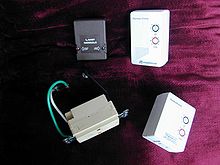
Back اكس 10(معيار المصنع) Arabic X10 (estàndard) Catalan X10 (Protokoll) German X10 Spanish X10 Estonian X10 (protokolla) Finnish X10 (informatique) French X10 (protocolo) Galician X10 ID X10 (standard) Italian
This article has multiple issues. Please help improve it or discuss these issues on the talk page. (Learn how and when to remove these template messages)
|

X10 is a protocol for communication among electronic devices used for home automation (domotics). It primarily uses power line wiring for signaling and control, where the signals involve brief radio frequency bursts representing digital information. A wireless radio-based protocol transport is also defined.
X10 was developed in 1975 by Pico Electronics of Glenrothes, Scotland, in order to allow remote control of home devices and appliances. It was the first general purpose domotic network technology and remains the most widely available[citation needed].[1]
Although a number of higher-bandwidth alternatives exist, X10 remains popular in the home environment with millions of units in use worldwide, and inexpensive availability of new components.
- ^ Rye, Dave (October 1999). "My Life at X10". AV and Automation Industry eMagazine. Archived from the original on 2016-10-15. Retrieved October 10, 2019.